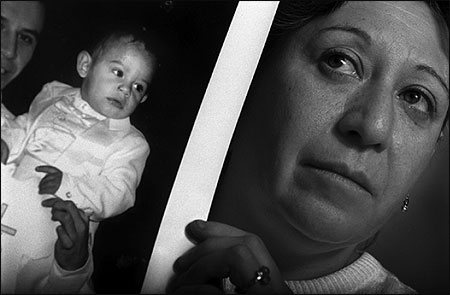On Super Bowl Sunday 1999, two-year-old Miguel Arias-Baca lay dying on the bathroom floor of his suburban Denver foster home. Miguel’s foster father, who had been drinking at a Broncos victory party, was upset that Miguel had soiled his diaper. He smeared the toddler’s face in his own feces and threw him to the ground. As Miguel’s brain swelled with blood, his foster parents waited more than four hours before they took him to the hospital. The child, whose body was covered in bruises, never regained consciousness. He died in the hospital before his biological family could be located.
When I looked into the case for The Denver Post, records revealed even more disturbing details about Miguel’s foster parents, Ricky and E’von Haney: They both had criminal arrest records. Foster care was their sole source of income. They hopped from one private foster care business to another, once after Ricky Haney’s stepdaughter accused him of abuse.
Reporter Kirk Mitchell and I decided to find out if the problems were systemic. We were shocked by what we found during our seven months of investigative reporting. Foster children, who are wards of the state taken from abusive or neglectful relatives, often suffered again in homes that meant to keep them from harm. Each abuse case seemed worse than the next. One foster child was forced to have sex with a dog. One foster father promised his 13-year-old foster daughter he’d leave his wife for her, then had sex with her in the basement. One foster mom forced her kids to use a bucket for a toilet.
Still, private, for-profit and nonprofit foster care companies were making millions as they were paid with taxpayer subsidies as compensation for placing these children and overseeing their care. Once some of these stories were confirmed, it didn’t take much for us to convince our editors that this mistreatment of children was a topic worthy of an in-depth investigation. Projects Editor Dan Meyers and Assistant Projects Editor Jeff Roberts made sure we had the time to report and space to publish the five-day series, which ran in late May.
As we tried to learn more about the private foster care businesses—a $37 million-per-year industry in Colorado—Kirk and I ran into one confidentiality roadblock after another. Colorado laws, like those in many other states, keep confidential the names of foster children and the circumstances surrounding their care as government wards. While the state contended that confidentiality rules protect foster children, we found the laws often shielded the various agencies and the state from outside scrutiny. This absence of oversight meant that foster children who were maltreated often went unnoticed. Added to this were reporting problems associated with trying to unearth information from private companies; it was difficult enough to get the public agencies to release public records (with the claims of confidentiality) but the involvement of private companies made our job that much more difficult. With some of the for-profit agencies, for example, we were never able to learn how they spent the money they received from the state. (At least nonprofit agencies need to file a Form 990 that gives financial disclosure.)
In our work to connect what scarce information there was on this largely unregulated industry, we crunched 1.8 million computer records from five state databases. We created computer tables to track inspection reports, abuse complaints, related companies, and the assets of company directors and executives. The computer analysis, in turn, pointed us to court records, police reports, and nonprofit tax returns, which filled in many details either omitted or redacted from state foster care records.
Even news got in the way of our series. The day I was supposed to meet with Assistant Managing Editor Frank Scandale to plan the investigation was the same day that Eric Harris and Dylan Klebold opened fire on their classmates at Columbine High School. That meeting didn’t happen. The project was put on hold for six months while we all focused on Columbine.
While the business of foster care has boomed in Colorado, our investigation—which was the first of its kind in our state—showed that the state has made it easier for the industry to skirt rules that were created to protect children. Foster care businesses have become “cash cows” in Colorado, one state official admitted. During the last 14 years, the number of foster homes recruited and supervised by private businesses increased by more than 800 percent. Colorado businesses have recruited foster parents who they sometimes knew had criminal records—including violent records—to care for abused and neglected children.
At the same time, changes in both foster care policies and laws made it easier for the emerging businesses to evade state rules. In 1994, the Colorado Legislature passed an industry-backed law that made it more difficult to crack down on problem foster care businesses. Faced with high caseloads, state foster care officials asked businesses to evaluate themselves by filling out a “self assessment” form. What business was going to turn itself in for breaking state rules? And it got more absurd. One inspector told us that her department was so strapped for cash that the state didn’t send the businesses assessment forms every year. Instead, the inspector asked business executives to reuse the old forms with a different color pen. Even when state officials discovered problems, they rarely used the laws available to discipline companies that put children in harm’s way.
Colorado officials poured more than three-quarters of the state’s 47.2 million foster care dollars into private businesses, even though our investigation showed that they didn’t know how the money was being spent. We found that much of that money was not spent on children. Through our tracking of financial records of both the foster care companies and their officers, we discovered that the director of one foster care business used state subsidies to pay the mortgage of his newly constructed “home office” in the foothills of the Rocky Mountains complete with a three-car garage, slate entryway, a sunny living room with a cathedral ceiling, and arched windows. At the same time, he sent foster children to a home with broken windows, only one toy and insufficient food, clothes or furniture. Other nonprofit agencies created for-profit arms. One nonprofit diverted more than $600,000 of state foster care subsidies into their for-profit arm, which was controlled by the same executives. The leaders of another foster care business made six-figure incomes off of taxpayer subsidies while children in their foster homes were molested and assaulted.
To get around confidentiality walls, we turned to computer databases. Colorado’s Department of Human Services kept extensive computer records on each foster child. Initially, we were told that those records were closed. We persisted: If the intent of the confidentiality laws was to protect the identity of abused and neglected children, why shouldn’t those records be publicly available if the children’s names were removed? With some basic programming, we knew the state could assign each child a unique number, allowing us to track kids through the system while keeping their identities secret. While it wasn’t easy, we eventually convinced the state to do exactly that. We used similar arguments to get data on state payments to foster care businesses and entrance to a databank of foster parents.
The first goal of our reporting was to confirm a hunch. The foster parents who cared for Miguel—the child who was killed—both had criminal arrest records. We suspected that many foster parents had rap sheets, so we took a database of foster parents and merged it with a database of Colorado criminals. Jeff Roberts, the paper’s computer-assisted reporting guru, also used a third commercial databank of motor vehicle, voter and property records to find other criminals living at the addresses of foster homes, such as live-in boyfriends or adult children of foster parents. With that list, we pulled court files and police records to make sure the foster parents and the criminals were the same people.
What we discovered is that just about anybody could become a foster parent. One foster mom got her job even though she had pleaded guilty to solicitation for prostitution. Another woman charged with selling drugs out of her daycare home was later recruited by two different foster care businesses. And a man who spent more than half of his adult life in prison for robbery and assault convictions became a foster dad. One foster care business executive even argued that having a criminal background might make someone a better foster parent.
When we researched the businesses that hired criminals, we found that shoddy background checks were just the beginning of the industry’s woes in Colorado. Licensing files showed that the state routinely allowed these businesses to break rules designed to protect children. Some companies had no records to show they had ever visited their foster homes to check on the children’s welfare. Some companies amassed hundreds of violations, and the state did nothing to stop them. The state’s fractured system allowed troubled foster parents to hop from one agency to another—even if another agency pushed them out because of abuse allegations. And children were getting molested and assaulted in their foster homes either by foster parents or other foster kids.
But the search for detailed records was frustrating. The state files were woefully incomplete. Often we’d find a cover sheet to a county abuse investigation that listed only the date of the investigation. We complained that the rest of the reports were missing but were told that the details were kept confidential to protect the victims. One goal of our story became to prove these bureaucrats wrong.
It wasn’t that tough to do. An internal company memo we uncovered showed how confidentiality rules can harm children. One foster child molested the eight-year-old biological son of his foster mother. The foster mother had not been told of the child’s record of molesting younger children at previous foster homes. Had the case records been open, she never would have taken the boy into her home. Her son never would have become a victim.
Before our series was published, Marva Livingston Hammons, Colorado’s Human Services chief, wrote a memo to certain state legislators outlining the major points of our investigation. “That’s for our survival,” her spokeswoman told us. “Jesus, do you want us to have it hit the front steps of the legislature without them knowing about it in advance? My God, we’d kill ourselves.” Once the series appeared, Hammons wrote defensive and sometimes misleading letters to the editor claiming her department had taken steps to fix the problems. And Governor Bill Owens refused to grant us an interview. His spokesman said the governor was confident that Hammons was fixing the flaws.
But the Colorado legislature didn’t buy it. Legislators convened a special committee to scrutinize the state’s role in what has become the foster care “scandal.” They crafted nine new laws that would overhaul the private foster-care system, subjecting both the businesses and their foster parents to greater scrutiny. One senator scolded the state for allowing foster care businesses to “line their pockets on the backs of children.” Lawmakers will vote on these proposed bills when the formal session begins in January.

Jeremy sits with his mother. At eight years old, Jeremy (not his real name) was sexually assaulted by a foster brother. Photo by Craig F. Walker, The Denver Post.

Anita Baca poses with a portrait of her grandson, Miguel Arias-Baca, at his christening. Miguelwas killed by his foster father, Ricky Haney, who pleaded guilty to child abuse caused by negligence resulting in death.
Patricia Callahan, who was part of The Denver Post’s Pulitzer Prize-winning Columbine team, now writes about the newspaper and biotechnology industries for The Wall Street Journal. Kirk Mitchell continues to cover the foster care fallout for The Denver Post.
When I looked into the case for The Denver Post, records revealed even more disturbing details about Miguel’s foster parents, Ricky and E’von Haney: They both had criminal arrest records. Foster care was their sole source of income. They hopped from one private foster care business to another, once after Ricky Haney’s stepdaughter accused him of abuse.
Reporter Kirk Mitchell and I decided to find out if the problems were systemic. We were shocked by what we found during our seven months of investigative reporting. Foster children, who are wards of the state taken from abusive or neglectful relatives, often suffered again in homes that meant to keep them from harm. Each abuse case seemed worse than the next. One foster child was forced to have sex with a dog. One foster father promised his 13-year-old foster daughter he’d leave his wife for her, then had sex with her in the basement. One foster mom forced her kids to use a bucket for a toilet.
Still, private, for-profit and nonprofit foster care companies were making millions as they were paid with taxpayer subsidies as compensation for placing these children and overseeing their care. Once some of these stories were confirmed, it didn’t take much for us to convince our editors that this mistreatment of children was a topic worthy of an in-depth investigation. Projects Editor Dan Meyers and Assistant Projects Editor Jeff Roberts made sure we had the time to report and space to publish the five-day series, which ran in late May.
As we tried to learn more about the private foster care businesses—a $37 million-per-year industry in Colorado—Kirk and I ran into one confidentiality roadblock after another. Colorado laws, like those in many other states, keep confidential the names of foster children and the circumstances surrounding their care as government wards. While the state contended that confidentiality rules protect foster children, we found the laws often shielded the various agencies and the state from outside scrutiny. This absence of oversight meant that foster children who were maltreated often went unnoticed. Added to this were reporting problems associated with trying to unearth information from private companies; it was difficult enough to get the public agencies to release public records (with the claims of confidentiality) but the involvement of private companies made our job that much more difficult. With some of the for-profit agencies, for example, we were never able to learn how they spent the money they received from the state. (At least nonprofit agencies need to file a Form 990 that gives financial disclosure.)
In our work to connect what scarce information there was on this largely unregulated industry, we crunched 1.8 million computer records from five state databases. We created computer tables to track inspection reports, abuse complaints, related companies, and the assets of company directors and executives. The computer analysis, in turn, pointed us to court records, police reports, and nonprofit tax returns, which filled in many details either omitted or redacted from state foster care records.
Even news got in the way of our series. The day I was supposed to meet with Assistant Managing Editor Frank Scandale to plan the investigation was the same day that Eric Harris and Dylan Klebold opened fire on their classmates at Columbine High School. That meeting didn’t happen. The project was put on hold for six months while we all focused on Columbine.
While the business of foster care has boomed in Colorado, our investigation—which was the first of its kind in our state—showed that the state has made it easier for the industry to skirt rules that were created to protect children. Foster care businesses have become “cash cows” in Colorado, one state official admitted. During the last 14 years, the number of foster homes recruited and supervised by private businesses increased by more than 800 percent. Colorado businesses have recruited foster parents who they sometimes knew had criminal records—including violent records—to care for abused and neglected children.
At the same time, changes in both foster care policies and laws made it easier for the emerging businesses to evade state rules. In 1994, the Colorado Legislature passed an industry-backed law that made it more difficult to crack down on problem foster care businesses. Faced with high caseloads, state foster care officials asked businesses to evaluate themselves by filling out a “self assessment” form. What business was going to turn itself in for breaking state rules? And it got more absurd. One inspector told us that her department was so strapped for cash that the state didn’t send the businesses assessment forms every year. Instead, the inspector asked business executives to reuse the old forms with a different color pen. Even when state officials discovered problems, they rarely used the laws available to discipline companies that put children in harm’s way.
Colorado officials poured more than three-quarters of the state’s 47.2 million foster care dollars into private businesses, even though our investigation showed that they didn’t know how the money was being spent. We found that much of that money was not spent on children. Through our tracking of financial records of both the foster care companies and their officers, we discovered that the director of one foster care business used state subsidies to pay the mortgage of his newly constructed “home office” in the foothills of the Rocky Mountains complete with a three-car garage, slate entryway, a sunny living room with a cathedral ceiling, and arched windows. At the same time, he sent foster children to a home with broken windows, only one toy and insufficient food, clothes or furniture. Other nonprofit agencies created for-profit arms. One nonprofit diverted more than $600,000 of state foster care subsidies into their for-profit arm, which was controlled by the same executives. The leaders of another foster care business made six-figure incomes off of taxpayer subsidies while children in their foster homes were molested and assaulted.
To get around confidentiality walls, we turned to computer databases. Colorado’s Department of Human Services kept extensive computer records on each foster child. Initially, we were told that those records were closed. We persisted: If the intent of the confidentiality laws was to protect the identity of abused and neglected children, why shouldn’t those records be publicly available if the children’s names were removed? With some basic programming, we knew the state could assign each child a unique number, allowing us to track kids through the system while keeping their identities secret. While it wasn’t easy, we eventually convinced the state to do exactly that. We used similar arguments to get data on state payments to foster care businesses and entrance to a databank of foster parents.
The first goal of our reporting was to confirm a hunch. The foster parents who cared for Miguel—the child who was killed—both had criminal arrest records. We suspected that many foster parents had rap sheets, so we took a database of foster parents and merged it with a database of Colorado criminals. Jeff Roberts, the paper’s computer-assisted reporting guru, also used a third commercial databank of motor vehicle, voter and property records to find other criminals living at the addresses of foster homes, such as live-in boyfriends or adult children of foster parents. With that list, we pulled court files and police records to make sure the foster parents and the criminals were the same people.
What we discovered is that just about anybody could become a foster parent. One foster mom got her job even though she had pleaded guilty to solicitation for prostitution. Another woman charged with selling drugs out of her daycare home was later recruited by two different foster care businesses. And a man who spent more than half of his adult life in prison for robbery and assault convictions became a foster dad. One foster care business executive even argued that having a criminal background might make someone a better foster parent.
When we researched the businesses that hired criminals, we found that shoddy background checks were just the beginning of the industry’s woes in Colorado. Licensing files showed that the state routinely allowed these businesses to break rules designed to protect children. Some companies had no records to show they had ever visited their foster homes to check on the children’s welfare. Some companies amassed hundreds of violations, and the state did nothing to stop them. The state’s fractured system allowed troubled foster parents to hop from one agency to another—even if another agency pushed them out because of abuse allegations. And children were getting molested and assaulted in their foster homes either by foster parents or other foster kids.
But the search for detailed records was frustrating. The state files were woefully incomplete. Often we’d find a cover sheet to a county abuse investigation that listed only the date of the investigation. We complained that the rest of the reports were missing but were told that the details were kept confidential to protect the victims. One goal of our story became to prove these bureaucrats wrong.
It wasn’t that tough to do. An internal company memo we uncovered showed how confidentiality rules can harm children. One foster child molested the eight-year-old biological son of his foster mother. The foster mother had not been told of the child’s record of molesting younger children at previous foster homes. Had the case records been open, she never would have taken the boy into her home. Her son never would have become a victim.
Before our series was published, Marva Livingston Hammons, Colorado’s Human Services chief, wrote a memo to certain state legislators outlining the major points of our investigation. “That’s for our survival,” her spokeswoman told us. “Jesus, do you want us to have it hit the front steps of the legislature without them knowing about it in advance? My God, we’d kill ourselves.” Once the series appeared, Hammons wrote defensive and sometimes misleading letters to the editor claiming her department had taken steps to fix the problems. And Governor Bill Owens refused to grant us an interview. His spokesman said the governor was confident that Hammons was fixing the flaws.
But the Colorado legislature didn’t buy it. Legislators convened a special committee to scrutinize the state’s role in what has become the foster care “scandal.” They crafted nine new laws that would overhaul the private foster-care system, subjecting both the businesses and their foster parents to greater scrutiny. One senator scolded the state for allowing foster care businesses to “line their pockets on the backs of children.” Lawmakers will vote on these proposed bills when the formal session begins in January.

Jeremy sits with his mother. At eight years old, Jeremy (not his real name) was sexually assaulted by a foster brother. Photo by Craig F. Walker, The Denver Post.

Anita Baca poses with a portrait of her grandson, Miguel Arias-Baca, at his christening. Miguelwas killed by his foster father, Ricky Haney, who pleaded guilty to child abuse caused by negligence resulting in death.
Patricia Callahan, who was part of The Denver Post’s Pulitzer Prize-winning Columbine team, now writes about the newspaper and biotechnology industries for The Wall Street Journal. Kirk Mitchell continues to cover the foster care fallout for The Denver Post.




